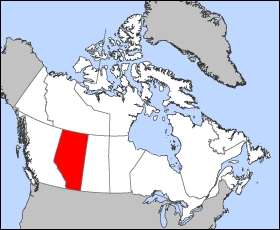Introduction to Alberta
Alberta is one of Canada's provinces. It celebrated 100 years as a province in 2005 on September 1st. As part of the Centennial celebration, Queen Elizabeth II and Prince Philip visited the province from May 23 to May 25, 2005.
Alberta's capital is the city of Edmonton. Its most populous city and metropolitan area, Calgary, is Alberta's commerce centre and is located in the southern region of the province. Other major cities and towns include Banff, Camrose, Wetaskiwin, Fort McMurray, Grande Prairie, Jasper, Lethbridge, Lloydminster, Medicine Hat, and Red Deer.
The Premier of the province is Ralph Klein.
Alberta is named after Princess Louise Caroline Alberta (1848-1939), the fourth daughter of Queen Victoria. Princess Louise was also the wife of Sir John Campbell, who was the Governor General of Canada from 1878-1883. Lake Louise was also named in honour of Princess Louise.
Geography
Alberta is in western Canada, with an area of 661,190 km² (255,287 mi²). Southwards, at 49° north, it borders the US state of Montana. Eastwards at 110° west it borders the province of Saskatchewan. At 60° north it is separated from the Northwest Territories. To the west, its border with British Columbia follows the line of peaks of the Rocky Mountains range along the Continental Divide, which runs northwesterly, until it reaches 120° west, at which point the border follows this meridian to 60° north.
With the exception of the southern section, the province is well watered. Alberta contains dozens of rivers and lakes ideal for swimming, water skiing, fishing and a full range of other water sports. There are a multitude of fresh-water lakes each less than 260 km² situated in Alberta, and three of more considerable size. These are Lake Athabasca, 7898 km², part of which is in the province of Saskatchewan, Lake Claire, 1436 km², and Lesser Slave Lake, 1168 km².
As Alberta extends for 1200 km from north to south, and about 600 km wide at its greatest east-west extent, it is natural that the climate should vary considerably between parallels of 49° and 60° north and also between 110° and 120° west. It is also further influenced by the different altitudes above sea level of the different parts of the province.
Northern Alberta has fewer frost-free days than southern Alberta, which is almost desert-like in its summer heat and lack of rain. Western Alberta is protected by the mountains, and enjoys the warmth brought by winter chinook winds, while eastern Alberta is flat, dry prairie, where temperatures can range from very cold (−35°C (−31°F) in the winter) to very hot (+35°C (+95°F) in the summer). Central and southern Alberta are the most likely places in Canada to experience tornadoes because of the summer heat, and violent summer thunderstorms are common in the eastern half of the province.
Alberta's capital city, Edmonton, is located almost exactly in the centre of the province, and most of Alberta's oil is refined here. Southern Alberta, where Calgary is located, is known for its ranching, and cattle run free through the whole winter. Much of the unforested part of Alberta is given over either to grain or to dairy farming, with ranching predominantly a southern Alberta industry.
In southeastern Alberta, where the Red Deer River traverses the flat prairie and farmland, are the Alberta badlands with deep gorges and striking landforms. Dinosaur Provincial Park, near Drumheller, Alberta, showcases the badlands terrain, desert flora, and remnants from Alberta's past when dinosaurs roamed the then lush landscape.
Overall, Alberta has cool winters, with a daytime average of about −10°C (14°F) in the south to −24°C (−12°F) in the north. In the summer the temperature averages about 13°C (55°F) in the Rocky Mountains and 18°C (64°F) in the dry prairie to the south-east.
Alberta is one of only two Canadian provinces or territories to have no maritime coast (the other being the neighbouring province of Saskatchewan.)

 The flag of Alberta, Canada was adopted on 1 June 1968.
The flag of Alberta, Canada was adopted on 1 June 1968.